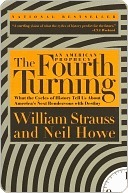More on this book
Community
Kindle Notes & Highlights
Read between
August 14 - August 23, 2023
Around World War II, we were proud as a people but modest as individuals. Fewer than two people in ten said yes when asked, Are you a very important person? Today, more than six in ten say yes. Where we once thought ourselves collectively strong, we now regard ourselves as individually entitled.
Popular trust in virtually every American institution—from businesses and governments to churches and newspapers—keeps falling to new lows. Public debts soar, the middle class shrinks, welfare dependencies deepen, and cultural arguments worsen by the year.
at the core of modern history lies this remarkable pattern: Over the past five centuries, Anglo-American society has entered a new era—a new turning—every two decades or so. At the start of each turning, people change how they feel about themselves, the culture, the nation, and the future. Turnings come in cycles of four. Each cycle spans the length of a long human life, roughly eighty to one hundred years, a unit of time the ancients called the saeculum. Together, the four turnings of the saeculum comprise history’s seasonal rhythm of growth, maturation, entropy, and destruction:
Before, people prized the ability to divine nature’s energy and use it. Today, we prize the ability to defy nature’s energy and overcome it.
Polls reveal that history is now the subject high school students find of least interest or worth. In pop parlance, that’s history has come to mean “that’s irrelevant.”
When we dam a river or industrialize a society, for example, we might eliminate the cycle of floods or wars; then again, we might just ensure that the cycle is both less frequent and more devastating.
When you recall your personal markers of life and time, the events you remember most are suffused with the emotional complexion of your phase of life at the time.
Each time younger generations replace older ones in each phase of life, the composite life cycle becomes something altogether new, fundamentally changing the entire society’s mood and behavior.
In childhood, the indulged Boomers were replaced by the neglected 13th Generation (born 1961–1981), who were left unprotected at a time of cultural convulsion and adult self-discovery. Known in pop culture as Generation X, its name here reflects the fact that it is literally the thirteenth generation to call itself American.
Without plant death, weeds would strangle the forest. Without human death, memories would never die, and unbroken habits and customs would strangle civilization. Social institutions require no less. Just as floods replenish soils and fires rejuvenate forests, a Fourth Turning clears out society’s exhausted elements and creates an opportunity for fresh growth.
linked this to the gradual decay of the “living memory of a previous war.” Eventually, he observed, the veterans’ heirs who “know War only by hearsay” come into power and resume the original war-prone pattern of behavior.
In a Crisis, older people give orders while the young do great deeds; in an Awakening, the old are the deed doers and the young are the order givers.
Pythagoras was among the first Western thinkers to interpret life as a cycle of four phases, each roughly twenty years long and each associated with a season: the spring of childhood, the summer of youth, the harvest of midlife, and the winter of old age.
When does midlife begin? According to many authorities (Browne, Ortega, Jung, Levinson), it begins sometime between the fortieth and forty-fifth year. Aristotle wrote that a person’s physical zenith is reached at age thirty-five, his mental zenith at age forty-nine; the average is age forty-two.
For example, the U.S. election of 1868 turned out to be the largest generational landslide ever recorded, as the weary voters and candidates who fought the Civil War threw out the principled leaders and generals who led it.
The term Generation X was a self-label first popularized by young literati born between 1961 and 1964, and its central purpose was to deny Boomer membership. Even when a generation
“It is one of nature’s ways,” Igor Stravinsky once observed, “that we often feel closer to distant generations than to the generation immediately preceding us.” The affinity between grandparent and grandchild is universal folk wisdom.
Your generation isn’t like the generation that shaped you, but it has much in common with the generation that shaped the generation that shaped you. Archetypes do not create archetypes like themselves; instead, they create the shadows of archetypes like themselves.
A key consequence of these cross-cycle shadow relationships is a recurring pattern that lies at the heart of the saeculum: an oscillation between the overprotection and underprotection of children.
Every forty years or so—always during a Crisis or Awakening—a new “realigning election” gives birth to a “new political party system.”
Feminism, as a popular movement, bursts on the scene during an Awakening. During an Unraveling, the gap between acceptable gender roles shrinks to its narrowest point. The efficacy of masculine power (and feminine morality) is reidealized during a Crisis. During a High, the gap between acceptable gender roles grows to its widest point, after which the cycle repeats.
Friedan implicitly had these seasonal rhythms in mind when she observed that just after World War II younger women had been steered out of public vocations and thrown “back” onto the domestic pedestal.
In a High, people want to belong; in an Awakening, to defy; in an Unraveling, to separate; in a Crisis, to gather.


